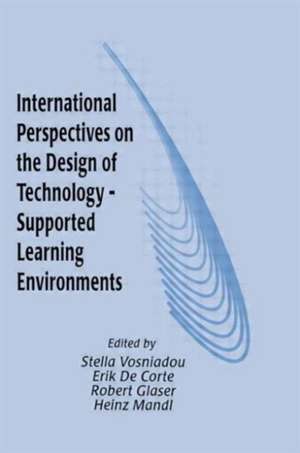International Perspectives on the Design of Technology-supported Learning Environments
Editat de Stella Vosniadou, Erik De Corte, Robert Glaser, Heinz Mandlen Limba Engleză Paperback – feb 1996
The emphasis in this book is not on the design of educational software but on the design of learning environments. A great deal of research on learning and instruction has recently moved out of the laboratory into the design of applications in instructional settings. By designing technology-supported learning environments instructional scientists attempt to better understand the theories and principles that are explicit in their theories of learning. The contributors to this volume examine how factors such as social interaction, the creation of meaningful activities, the use of multiple perspectives, and the construction of concrete representations influence the acquisition of new information and transfer.
Preț: 135.64 lei
Nou
Puncte Express: 203
Preț estimativ în valută:
25.96€ • 27.75$ • 21.64£
25.96€ • 27.75$ • 21.64£
Carte tipărită la comandă
Livrare economică 17 aprilie-01 mai
Preluare comenzi: 021 569.72.76
Specificații
ISBN-13: 9780805818536
ISBN-10: 0805818537
Pagini: 408
Dimensiuni: 152 x 229 x 21 mm
Greutate: 0.54 kg
Ediția:1
Editura: Taylor & Francis
Colecția Routledge
Locul publicării:Oxford, United Kingdom
ISBN-10: 0805818537
Pagini: 408
Dimensiuni: 152 x 229 x 21 mm
Greutate: 0.54 kg
Ediția:1
Editura: Taylor & Francis
Colecția Routledge
Locul publicării:Oxford, United Kingdom
Public țintă
ProfessionalCuprins
Contents: Preface. R. Glaser, E.L. Ferguson, S. Vosniadou, Introduction: Cognition and the Design of Environments for Learning. Part I: Representation. S. Vosniadou, Learning Environments for Representational Growth and Cognitive Flexibility. J. Bliss, Externalizing Thinking Through Modeling: ESRC Tools for Exploratory Learning Research Program. R. Kozma, J. Russell, T. Jones, N. Marx, J. Davis, The Use of Multiple, Linked Representations to Facilitate Science Understanding. B. Schwarz, M.J. Nathan, L.B. Resnick, Acquisition of Meaning for Arithmetic Structures with the Planner. K. Reusser, From Cognitive Modeling to the Design of Pedagogical Tools. E. Lehtinen, S. Repo, Activity, Social Interaction, and Reflective Abstraction: Learning Advanced Mathematical Concepts in a Computer Environment. E. De Corte, Changing Views of Computer-Suppported Learning Environments for the Acquistion of Knowledge and Thinking Skills. Part II: Social Interaction. M. Scardamalia, C. Bereiter, Adaptation and Understanding: A Case for New Cultures of Schooling. P. Dillenbourg, Distributing Cognition Over Humans and Machines. G. Kanselaar, G. Erkens, Interactivity in Cooperative Problem Solving with Computers. J. Torney-Purta, Conceptual Change Among Adolescents Using Computer Networks and Peer Collaboration in Studying International Political Issues. Part III: Meaningful Contexts and Multiple Perspectives. J.D. Bransford et al., MOST Environments for Accelerating Literacy Development. S.R. Goldman et al., Anchoring Science Instruction in Multimedia Learning Environments. Cognition and Technology Group at Vanderbilt, Multimedia Environments for Enhancing Learning in Mathematics. H. Mandl, H. Gruber, A. Renkl, Learning to Apply: From "School Garden Instruction" to Techonolgy-Based Learning Environments. P. Mendelsohn, Mapping Models of Cognitive Development to Design Principles of Learning Environments. Part IV: Principles of System Design. A. Collins, Design Issues for Learning Environments. G. Salomon, Studying Novel Learning Environments as Patterns of Change.
Recenzii
"...introduces the reader to some of the key international developers who are designing instructional settings to improve education and add to our knowledge of instructional-learning theory....through the many applications presented in the 18 chapters, the reader can appreciate the bidirectional effect of research on new developments in both practice and theory....this book is full of new approaches to learning and instruction and is an important addition to your personal library."
—Journal of Computing in Higher Education
"The editors of this fine book have been working cooperatively on topics in instructional psychology and technology for a long time. I recommend this book for use in seminars dealing with instructional design and technology. Each chapter presents foundational information that is valuable for the novice reader while presenting case studies for the advanced scientist. As such, the book serves as a reference guide for the international instructional design field."
—Journal of Educational Computing Research
"There is much here that is of interest, importance, and relevance for a wide range of educationists and researchers....it is likely to that many of those involved in the design and use of technology-supported learning environments will find useful reading here."
—British Educational Research Journal
—Journal of Computing in Higher Education
"The editors of this fine book have been working cooperatively on topics in instructional psychology and technology for a long time. I recommend this book for use in seminars dealing with instructional design and technology. Each chapter presents foundational information that is valuable for the novice reader while presenting case studies for the advanced scientist. As such, the book serves as a reference guide for the international instructional design field."
—Journal of Educational Computing Research
"There is much here that is of interest, importance, and relevance for a wide range of educationists and researchers....it is likely to that many of those involved in the design and use of technology-supported learning environments will find useful reading here."
—British Educational Research Journal
Notă biografică
Robert Glaser, Stella Vosniadou, Erik De Corte, Heinz Mandl











